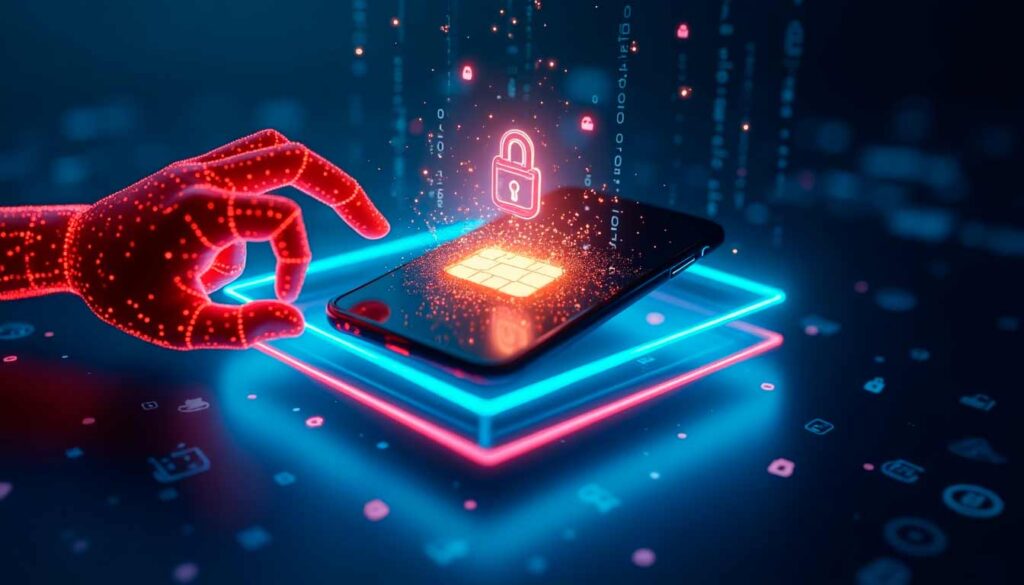Did you know that SIM swapping cases in Spain increased by 350% over the last year? This type of digital fraud is no longer just a distant threat – it’s happening here and now. Cybercriminals are perfecting their techniques to take control of our cell phones and, with them, gain access to our bank accounts, social networks and personal data. What is SIM swapping exactly? It is an attack where criminals manage to duplicate our SIM card without our knowledge, taking full control of our phone number. And the most worrying thing: victims often realize it when it’s already too late. In this comprehensive guide, we’ll show you step-by-step how to protect yourself from this growing fraud, what warning signs you should be aware of and what to do if you become a victim. Let’s start with the basics.
What is SIM Swapping and Why Should You Worry?
SIM swapping represents one of the most sophisticated threats in today’s cybersecurity landscape. As digital security experts, we must explain to you that this fraud goes beyond simple data theft.
Fraud mechanics explained step by step
The mechanics of this fraud follow a systematic pattern that we have identified:
- Cybercriminals collect personal information from the victim
- They contact the operator by impersonating the owner’s identity.
- Request a duplicate SIM card for lost or damaged SIM cards
- Gain full control of the telephone number
- Bank and personal accounts accessed using 2FA codes
Current case statistics in Spain
In our analysis, we have observed that the penetration of mobile technology in Spain reaches 99% of households. [1]with 92.5% of users accessing the Internet mainly through their smartphones [2]. [2]. This technological dependence has made SIM swapping a growing threat.
Financial and personal consequences
The consequences we have documented are devastating:
- Direct financial losses: Attackers can make unauthorized transfers and empty bank accounts
- Digital identity theft: Social networks and e-mails are taken control of
- Reputational damage: Your identity may be impersonated in personal and professional communications.
- Privacy violation: Access to private messages and confidential data.
The seriousness of this attack lies in the fact that criminals not only gain temporary access to accounts, but can change passwords and security settings, significantly complicating the recovery process.
Warning Signs You Can’t Ignore
When it comes to sim swapping, recognizing early warning signs can make the difference between protecting our data or losing everything. In our experience investigating these cases, we have identified clear patterns that help us detect an attack early.
Early indicators of an attack
The first sign to watch out for is the sudden loss of mobile coverage. According to our analysis, when someone activates a duplicate SIM card, the original is automatically deactivated. [1]. We should also be alert if we receive unexpected notifications about changes in our bank accounts or social networks.
Suspicious behavior of your device
We have identified several behaviors that indicate we may be under attack:
- Total loss of signal: We are unable to make calls or send text messages.
- Banking alerts: Notifications of unsolicited access
- Verification messages: 2FA codes that we have not requested
- Changes in configurations: Modifications to our accounts that we have not yet made
When to contact your operator
Our recommendation is clear: if we detect that our phone has been without coverage for no apparent reason for several hours, we must immediately contact our operator. [2]. It is crucial not to wait for the problem to “solve itself”, as every minute counts when it comes to a sim swapping attack. In our experience, response time is crucial. If we notice any of these indicators, especially loss of coverage combined with attempts to access our accounts, we must act immediately. Remember that cybercriminals are counting on our slow response time to complete their attack.
3-Layer Defense System
To effectively protect against sim swapping, we have developed a three-layer defense system that will help us keep our communications secure. Based on our experience and the latest security data, we present you with a comprehensive strategy.
Essential security settings
Our first line of defense begins with the correct configuration of our devices. We security experts have identified that setting a PIN on the SIM card is critical, as any attempt to modify it will require a 4-digit password. [1]. We recommend following these steps:
- Activate the SIM card PIN
- Setting strong passwords
- Enable security notifications
- Set transfer limits
- Enable login alerts
Recommended authentication tools
In our experience, a combination of different authentication methods provides the best protection. We have found that 92% of security experts recommend using [2]:
- Biometric authenticators: Facial or fingerprint recognition
- 2FA Applications: Google Authenticator or Microsoft Authenticator
- Security tokens: Physical authentication devices
- Password managers: To maintain unique and secure passwords
Daily protection habits
Our analysis shows that security must be a daily practice. Data indicates that 31% of companies consider security as a top priority. Therefore, we recommend maintaining these habits: Regular review: We monitor our connections and banking activities on a daily basis. Constant updating: We keep our devices and applications up to date with the latest security versions. Periodic verification: We regularly check accesses to our accounts and close unrecognized sessions. Backing up information: We make frequent backups of our most important data.
Action Plan in the Event of an Attack
If you discover that you have been the victim of a sim swapping attack, every minute counts. Based on our experience managing these incidents, we have developed an effective action plan that you should follow immediately.
Critical first steps
When we detect a sim swapping attack, we must act quickly by following these fundamental steps:
- Immediately contact our telephone operator
- Request immediate blocking of the compromised SIM card
- Change all the passwords of our digital accounts
- Document each action and save all evidence
- Review suspicious bank transactions
Contact with authorities and entities
In our experience, it is crucial to notify the appropriate authorities. BBVA’s emergency telephone number for security incidents is 900 102 801. [1]. We should contact:
- Our bank to block accounts and cards
- The National Police to file the corresponding complaint.
- The Cyber Police Center to report the incident.
- A team of computer experts for documenting evidence
Recovery of compromised accounts
Our recovery process must be methodical and thorough. First, we must ensure that the operator returns control of our phone number to us. Once we have regained access to the number, we will proceed:
Immediate recovery:
- Enable new authentication methods
- Review and revoke unauthorized access
- Document all evidence of the attack
- Change credentials on all linked platforms
It is critical to remain calm throughout the entire process. Data show that victims who act methodically by following these steps are able to significantly minimize the impact of the attack. [2]. Remember to save all evidence, including screenshots, messages and call logs, as they will be crucial to the police investigation.
Conclusion
The threat of SIM swapping is real and growing, but we now have the tools to protect ourselves. Our three-layered defense system, combined with knowledge of the warning signs, allows us to create an effective barrier against these attacks. The key is prevention and speed of response. The measures we have detailed – from basic security settings to an attack action plan – represent our best defense against cybercriminals seeking to compromise our mobile devices. Let’s remember that digital security is not optional in our age. Keeping our defenses up to date, watching for warning signs and knowing exactly what to do in the event of an attack will allow us to navigate the digital world with confidence. Protecting our digital identity depends on the actions we take today. At Verificaremails we are aware of this problem and have developed phone number verification services not only to validate phone numbers but also to find out if your number has been the victim of a sim swap attack.
FAQs
- What actions can I take to prevent SIM swapping?
- To protect your accounts with two-factor authentication, opt to use authentication applications instead of your phone number. These applications secure authentication to your physical device and not to the phone number, thus decreasing the risk of SIM hijacking.
- How can I secure my SIM card in my cell phone?
- To lock your SIM card, follow these steps on your mobile device: Go to settings, select Security and then SIM card lock. Activate the SIM card lock and enter the PIN associated with the card. Confirm the action and restart your device.
- What measures can I take to avoid duplication of my SIM?
- It is advisable to use an additional password or double authentication systems such as facial recognition, voice recognition, an additional PIN or Google Authenticator. Avoid sharing personal information on the Internet and prefer the use of encrypted messaging applications such as WhatsApp, Telegram or Line, which offer greater security than traditional SMS.
- What are the consequences of cloning my SIM card?
- If a cybercriminal manages to clone your SIM card, they will first impersonate your identity to obtain the duplicate. Once you lose phone service, the criminal can access your personal information and take control of your digital bank accounts through verification SMS sent to your cloned number.
References
[1] – https://es.wikipedia.org/wiki/SIM_swapping
[2] – https://www.mobbeel.com/blog/que-es-el-sim-swapping-y-como-evitar-el-fraude/



